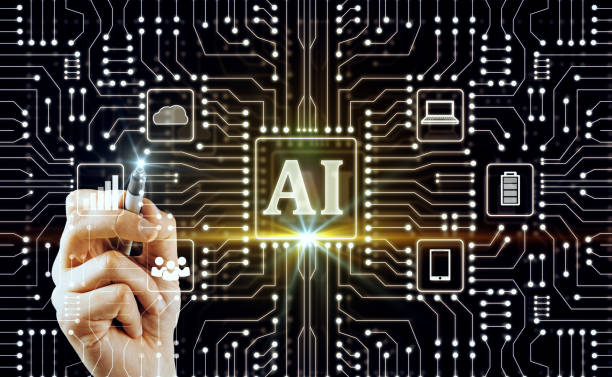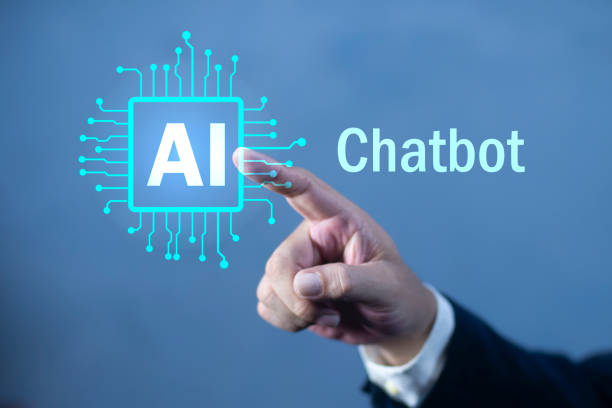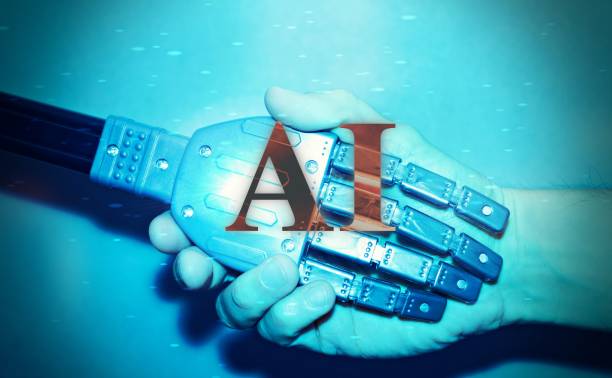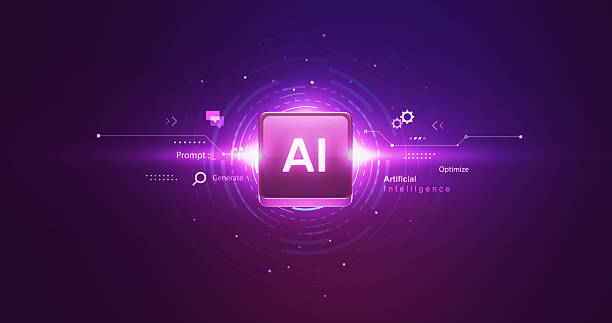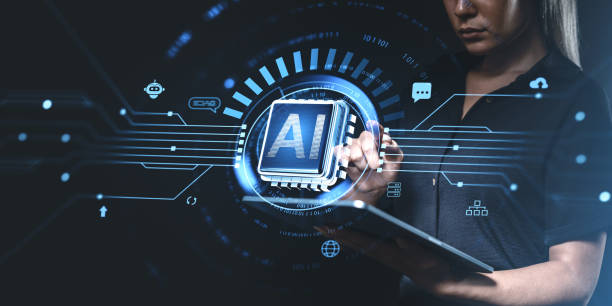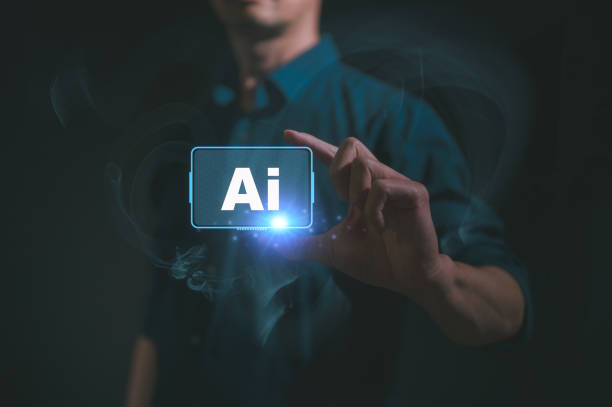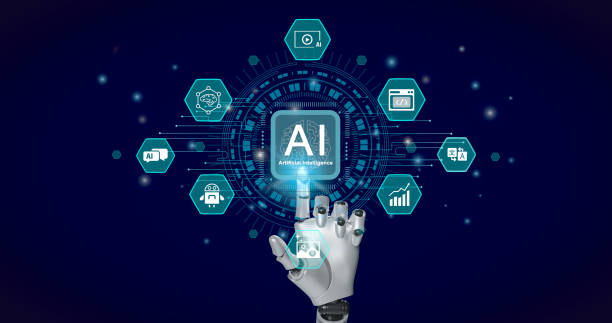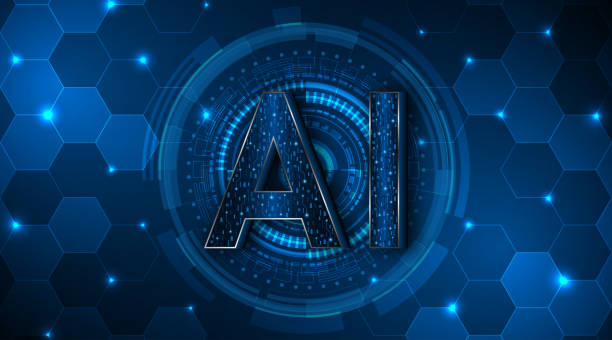What is an Artificial Intelligence Robot and How Does It Work?
An Artificial Intelligence Robot is a combination of two separate fields: #Artificial_Intelligence and #Robotics.
Artificial intelligence gives machines the ability to perform tasks that typically require human intelligence, such as learning, problem-solving, and decision-making.
Robotics deals with the design, construction, operation, and application of robots.
An AI robot is, in fact, a physical or virtual robot that is controlled by artificial intelligence algorithms.
The operation of an AI robot typically involves the following steps:
- Data Acquisition: The robot collects information about its surroundings through sensors, cameras, and other input devices.
- Data Processing: The collected data is processed by artificial intelligence algorithms.
These algorithms can include neural networks, machine learning algorithms, and other AI methods. - Decision Making: Based on data processing, the robot decides what action to take.
This decision-making can include movement, manipulation of objects, or interaction with humans. - Execution: The robot executes the desired action using actuators, such as motors and arms.
To better understand, imagine you have an AI robot whose job is to move packages in a warehouse.
This robot uses cameras and sensors to scan its surroundings and identify the location of packages and obstacles.
Then, artificial intelligence algorithms help the robot find the best path to reach and move the package.
Finally, the robot uses motors and arms to pick up the package and move it to the desired location.
This type of AI robot has widespread applications in various industries, including manufacturing, logistics, healthcare, and customer service.
Artificial intelligence provides new possibilities for automation and efficiency improvement in these industries.
Did you know that a weak company website loses you many opportunities every day? Solve this problem forever with professional company website design by Rasaweb!
✅ Create a powerful and reliable image of your brand
✅ Attract new targeted customers and increase sales
⚡ [Get free website design consultation]
Types of Artificial Intelligence Robots and Their Applications
AI robots can be categorized based on various criteria, including the type of function, the type of work environment, and the type of artificial intelligence used.
Here, we refer to some of the common types of AI robots and their applications:
- Industrial Robots: These robots are designed to perform repetitive and heavy tasks in industrial environments.
They can be used in production lines, assembling parts, welding, and painting. - Service Robots: These robots are designed to provide services to humans.
They can be used in hospitals, hotels, restaurants, and homes.
Cleaning robots, nursing robots, and waiter robots are examples of service robots. - Search and Rescue Robots: These robots are designed to help humans in emergency situations.
They can be used in earthquakes, floods, and other natural disasters to find and rescue trapped people. - Military Robots: These robots are designed to perform military tasks, such as reconnaissance, mine clearance, and transportation of equipment.
- Space Robots: These robots are designed to explore and investigate space.
They can sample soil from planets, repair satellites, and conduct scientific experiments.
Each of these types of AI robots uses different artificial intelligence algorithms, depending on its specific application.
For example, industrial robots often use reinforcement learning algorithms to optimize their movements, while service robots may use natural language processing to interact with humans.
With the advancement of technology, AI robots are expected to play an increasingly important role in our lives.
They can help us perform daily tasks, increase the efficiency of industries, and even save human lives.
The use of #Artificial_Intelligence in robots is expanding.
Advantages and Disadvantages of Using Artificial Intelligence Robots
The use of AI robots has several advantages and disadvantages, some of the most important of which are mentioned here.
Advantages
- Increased Efficiency: Robots can perform tasks faster and more accurately than humans, especially in repetitive and tedious tasks.
- Cost Reduction: By automating tasks, human labor costs can be reduced.
- Improved Safety: Robots can work in dangerous environments without endangering human lives.
- Increased Quality: Robots can work with high precision and prevent errors.
- 24/7 Availability: Robots do not need rest and can work around the clock.
Disadvantages
- High Initial Cost: Buying and setting up robots can be costly.
- Need for Expertise: Trained specialists are needed to maintain and repair robots.
- Job Loss: Automation of tasks can lead to the loss of human jobs.
- Ethical Issues: The use of robots in some areas, such as military, can raise ethical issues.
- Dependence on Technology: If there is a problem with robotic systems, processes may be disrupted.
Deciding whether to use AI robots requires careful consideration of the advantages and disadvantages in light of the specific conditions of each organization or industry.
Also, attention should be paid to the ethical and social issues arising from the use of robots.
This #Artificial_Intelligence_Robot is transforming various industries.
| Advantages |
|---|
| Increased Efficiency |
| Cost Reduction |
| Improved Safety |
| Increased Quality |
Click here to preview your posts with PRO themes ››
Challenges in Developing and Implementing Artificial Intelligence Robots
The development and implementation of AI robots is associated with several challenges, some of the most important of which are mentioned here.
- Algorithm Complexity: Designing and implementing artificial intelligence algorithms is complex and time-consuming.
For a robot to operate effectively in complex environments, it needs advanced algorithms that can correctly interpret sensor data and make appropriate decisions. - Hardware Limitations: Robots need powerful hardware to run artificial intelligence algorithms and interact with their surroundings.
Developing suitable hardware for robots, given the size, weight, and power consumption limitations, is a major challenge. - Cybersecurity: Robots are vulnerable to cyberattacks.
Hackers can gain control of robots by infiltrating robotic systems and using them to carry out malicious actions. - Legal and Ethical Issues: The use of robots in some areas, such as military and healthcare, raises legal and ethical issues.
For example, who is responsible for the damages caused by a self-driving robot? Or is it ethical to use robots to kill humans? - Social Acceptance: Some people resist the use of robots in their lives.
They may be worried about losing their jobs, or they may feel that robots are a threat to their privacy and security.
Overcoming these challenges requires collaboration between researchers, engineers, policymakers, and ordinary people.
Safety and security standards for robots must be developed, appropriate laws and regulations for the use of robots must be established, and public awareness of the advantages and disadvantages of robots must be increased.
The AI robot must be designed to benefit society.
Are you bothered by losing customers because of the outdated appearance or slow speed of your online store? The expert Rasaweb team solves these problems forever with professional online store website design!
✅ Increase customer trust and brand credibility
✅ Blazing speed and excellent user experience
Get a free consultation with Rasaweb now ⚡
Machine Learning and Its Role in Artificial Intelligence Robots
Machine Learning is a branch of artificial intelligence that gives machines the ability to learn from data without being explicitly programmed.
Machine learning plays a very important role in the development of AI robots.
Using machine learning algorithms, robots can:
- Better understand their surroundings: Robots can analyze sensor data and identify patterns in their surroundings using machine learning algorithms.
This helps them operate in complex and unpredictable environments. - Learn new skills: Robots can learn new skills using reinforcement learning algorithms.
For example, a robot can learn how to throw a ball or how to follow a path by practicing and repeating. - Make better decisions: Robots can make better decisions using machine learning algorithms.
For example, a robot can choose the best route to get to its destination by analyzing traffic data. - Interact better with humans: Robots can understand human language and interact with them naturally using natural language processing.
Some of the common machine learning algorithms used in AI robots include:
- Neural Networks: Neural networks are mathematical models inspired by the structure of the human brain.
They are used to learn complex patterns in data. - Support Vector Machines: Support Vector Machines (SVM) are machine learning algorithms that are used to classify data.
- Decision Trees: Decision trees are graphical models that are used to make decisions based on a set of rules.
- Clustering Algorithms: Clustering algorithms are used to group data based on their similarities.
Machine learning allows AI robots to continuously improve their performance and adapt to new conditions.
This allows robots to operate effectively in a wide range of applications, including manufacturing, logistics, healthcare, and customer service.
These types of robots can perform their tasks with greater accuracy and efficiency in dynamic and changing environments.
Sensors and Actuators are Key Components of Artificial Intelligence Robots
AI robots need sensors and actuators to interact with their surroundings.
Sensors are devices that collect information about the robot’s surroundings.
Actuators are devices that allow the robot to affect its surroundings.
Sensors
Different types of sensors are used in AI robots, including:
- Cameras: Cameras capture images and videos of the robot’s surroundings.
These images and videos can be used for object recognition, face detection, and navigation. - Lidar: Lidar is a remote sensing technology that uses lasers to measure the distance to objects.
Lidar can be used to create three-dimensional maps of the robot’s surroundings. - Radar: Radar is a remote sensing technology that uses radio waves to detect objects.
Radar can be used to detect objects in bad weather conditions, such as rain and fog. - Acoustic Sensors: Acoustic sensors record the sounds of the robot’s surroundings.
These sounds can be used for speech recognition, noise identification, and navigation. - Tactile Sensors: Tactile sensors measure pressure, temperature, and other physical properties of objects.
These sensors can be used for manipulating objects and interacting with humans.
Actuators
Different types of actuators are used in AI robots, including:
- Motors: Motors are used to move the robot and its arms.
- Cylinders: Cylinders are used to create linear motion.
- Grippers: Grippers are used to grab and manipulate objects.
- Speakers: Speakers are used to play sound.
- Display Screens: Display screens are used to display information to humans.
Click here to preview your posts with PRO themes ››
The choice of suitable sensors and actuators for an AI robot depends on its specific application.
For example, a self-driving robot needs cameras, lidar, and radar for navigation, while a surgical robot needs tactile sensors and precise grippers to perform surgery.
The development of #Artificial_Intelligence_Robot requires careful selection and coordination of these components.
What Will the Future of Artificial Intelligence Robots Be?
The future of AI robots looks very bright.
With the advancement of technology, robots are expected to become smarter, more capable, and more versatile.
Some of the important trends we will see in the future of AI robots include:
- Increased Intelligence: Robots will become smarter using more advanced machine learning algorithms and will be able to perform more complex tasks.
They can solve problems, make decisions, and interact with humans naturally. - Increased Autonomy: Robots will become more autonomous using more advanced sensors and algorithms and will be able to operate in unpredictable environments.
They can perform their tasks without human intervention. - Price Reduction: With increased production and technological advancement, the price of robots will decrease, and their use will become more affordable for businesses and individuals.
- Expanded Applications: Robots will be used in a wider range of applications, including manufacturing, logistics, healthcare, customer service, education, and entertainment.
- Greater Interaction with Humans: Robots will be able to interact with humans more naturally and effectively using natural language processing and facial recognition.
However, the development of AI robots also comes with challenges.
Attention must be paid to the ethical and social issues arising from the use of robots, including job loss, increased inequality, and threats to privacy.
Also, safety and security standards for robots must be developed to prevent accidents.
#Artificial_Intelligence_Robot can help improve the quality of human life, but it must be developed and used responsibly.
Important Points When Buying an Artificial Intelligence Robot
Buying an AI robot can be a big investment, so it’s important to do enough research and consider the important points before buying.
Here, we refer to some of the important points when buying an AI robot.
- Determine Needs: First of all, you must accurately determine your needs.
What tasks do you want to entrust to the robot? What type of environment will the robot work in? What budget have you allocated for buying the robot? - Research Different Types of Robots: There are different types of AI robots on the market, each with its own capabilities and limitations.
You should research different types of robots and choose a robot that best matches your needs. - Check Technical Specifications: The technical specifications of the robot, such as processing power, memory capacity, type of sensors and actuators, and battery life, must be compatible with your needs.
- Consider Additional Costs: In addition to the price of the robot itself, you should also consider additional costs such as installation, maintenance, repair, and training.
- Check Warranty and After-Sales Service: Before buying, make sure that the robot has a valid warranty and that the selling company provides adequate after-sales service.
- Read User Reviews: Reviews from other users can provide you with useful information about the performance and reliability of the robot.
Also, before buying, be sure to ask the seller to show you the robot and provide the opportunity to test it.
This helps you ensure the robot’s performance and compatibility with your needs.
Buying an AI robot requires accuracy and attention.
Artificial intelligence
| Criterion | Description |
|---|---|
| Determine Needs | Tasks expected from the robot |
| Technical Specifications | Check processing power and memory |
| Costs | Includes installation and maintenance costs |
| Warranty | Check warranty and after-sales service |
Are you tired of your online store website not being able to generate as much revenue as its potential? Rasaweb, a specialist in professional online store website design, solves this problem forever!
✅ Increase sales rate and revenue
✅ High loading speed and unparalleled user experience
⚡ Get a free online store website design consultation
The Impact of Artificial Intelligence Robots on Jobs and the Economy
The widespread use of AI robots will have a profound impact on jobs and the economy.
On the one hand, task automation can lead to increased productivity, reduced costs, and improved quality of products and services.
On the other hand, automation can lead to the loss of human jobs and increase economic inequality.
Some of the industries that will be most affected by AI robots include:
- Manufacturing: Robots can be used in production lines, assembly of parts, welding, and painting and increase efficiency and quality.
- Logistics: Robots can be used in warehousing, transportation, and delivery of goods and increase speed and accuracy.
- Healthcare: Robots can be used in surgery, nursing, and rehabilitation and improve the quality of patient care.
- Customer Service: Robots can be used in call centers, chatbots, and waiter robots and provide faster and better services to customers.
Click here to preview your posts with PRO themes ››
To be able to benefit from the advantages of AI robots and prevent their disadvantages, appropriate policies must be adopted.
These policies can include investing in education, creating new job opportunities, and supporting people who lose their jobs due to automation.
#Artificial_Intelligence and robotics must be developed in such a way that they benefit all members of society.
The AI robot can help economic growth, but it must be managed responsibly.
Important Security Points in Using Artificial Intelligence Robots
The use of AI robots requires adherence to important security points to prevent accidents and abuses.
Here, we refer to some of these points.
- Data Protection: Robots often have access to sensitive data, such as people’s personal information, financial information, and business information.
This data must be protected against unauthorized access. - Preventing Cyberattacks: Robots are vulnerable to cyberattacks.
Robotic systems must be protected against hacker intrusion. - Adherence to Safety Standards: Robots must be designed and manufactured in accordance with safety standards to prevent accidents.
- User Training: Robot users must receive the necessary training to be able to use robots safely and effectively.
- Performance Monitoring: The performance of robots should be monitored regularly to prevent problems and abuses.
Also, attention should be paid to the ethical issues arising from the use of robots.
For example, robots must be prevented from doing things that harm people’s rights and freedoms.
The AI robot must be designed and used in such a way that it benefits society and contributes to human security and well-being.
The development of AI robots must be accompanied by adherence to ethical and security principles.
Robot
FAQ
| Question | Answer |
|---|---|
| What is an Artificial Intelligence Robot? | It is a robot that uses the capabilities of artificial intelligence to understand the environment, reason, learn, and make decisions in order to perform complex tasks independently. |
| What is the main difference between a regular robot and an AI robot? | AI robots can learn and adapt to their environment, while regular robots usually operate based on fixed and pre-determined plans. |
| In what areas are AI robots used? | In areas such as industry (production lines), medicine (robotic surgeries), services (customer support, smart vacuum cleaners), exploration (space and underwater), and entertainment. |
| How do AI robots learn? | They acquire new skills through machine learning (Machine Learning) and deep learning (Deep Learning) algorithms, by analyzing large data and identifying patterns. |
| Can AI robots have feelings? | Currently, no. They can identify or simulate emotions, but they do not have a real experience of emotions like humans. |
| What are the most important advantages of using AI robots? | Increased productivity, reduced human error, performing dangerous or repetitive tasks, and providing new and efficient services. |
| What challenges exist in the development of AI robots? | The need for abundant and high-quality data, the complexity of algorithms, ethical issues, cybersecurity, and the high cost of research and development. |
| Are AI robots dangerous to humans? | By following safe design principles and ethical regulations, no. Concerns are more related to social and economic impacts such as changes in the labor market. |
| What is an example of an AI robot in everyday life? | Smart vacuum cleaner robots (such as Roomba) that automatically map and clean the house, or smart voice assistants (such as Siri and Alexa). |
| How is the future of AI robots predicted? | They are expected to become smarter, more autonomous, and able to interact more complexly with humans and play a more prominent role in industry, medicine, transportation, and everyday life. |
And other services of Rasa Web advertising agency in the field of advertising
Smart Content Strategy: An innovative service to increase online growth through precise audience targeting.
Smart Customer Journey Map: Professional optimization for analyzing customer behavior using a SEO-oriented content strategy.
Smart Sales Automation: Professional optimization to increase site visits using user experience customization.
Smart Direct Marketing: Transform online growth with marketing automation.
Smart Digital Branding: Transform campaign management with the help of optimizing key pages.
And more than hundreds of other services in the field of internet advertising, advertising consulting and organizational solutions
Internet Advertising | Advertising Strategy | Reportage Ad
Resources
What is a smart robot?
,IEEE
,What is an AI smart robot?
,Artificial intelligence
? To reach the peak of success in the digital space, Rasaweb Digital Marketing Agency is with your business with specialized services such as SEO optimized website design.
📍 Tehran, Mirdamad Street, next to the Central Bank, South Kazerun Alley, Ramin Alley No. 6

